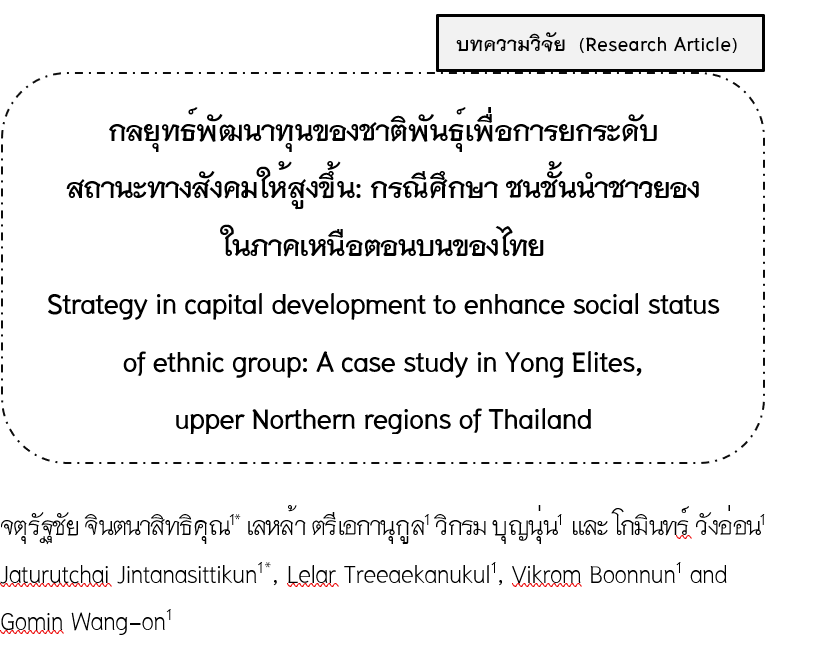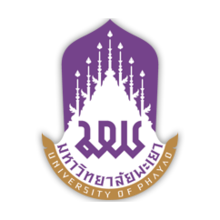Strategy in Capital Development to Enhance Social Status of Ethnic Group: A Case Study in Yong Elites, Upper Northern Regions of Thailand
Keywords:
Ethnic, Strategy, Yong PeopleAbstract
This qualitative research investigated strategies in developing ethnic capitals to strengthen their social status employed by Yong elites. Sixteen target groups for the study were Yong elites from 1) Pa Sang district, 2) Mueang Lamphun district in Lamphun 3) Buak Khang, San Kamphaeng district, Chiang Mai 4) Mae Chan, Chiang Rai. Data collection was done by deep interviewing and studying life history of the target groups. Besides, thirteen key informants were interviewed to fulfill some more special information. Data analysis was undergone by content analysis, SWOT analysis and triangulation in compared to participant observation and non-participant observation as well as review literature before presenting the research results.
The findings showed that from the past to the present, Yong elites in Upper Northern regions of Thailand have employed their strategies in developing ethnic capitals to strengthen their social status. There were 15 strategies found; for example, 1) the strategy in becoming Buddhist monks on purpose to enhance personal ability 2) the strategy in paying a visit and spending life in a big city for personal ability development 3) the strategy in spending economic capital for further education resulting in a well-known and powerful person in society 4) the strategy in applying personal abilities with economic capital to develop their cultural tourist attractions in order to strengthen great earning potential to the community. 5) the strategy in applying their personal abilities as well as their personal prestige in developing Yong connection to be a sustainable institutionalization of Yong.
References
กาญจนา แก้วเทพ และ สมสุข หินวิมาน. (2560). สายธารแห่งนักคิด ทฤษฎีเศรษฐศาสตร์การเมืองกับสื่อสารศึกษา (พิมพ์ครั้งที่ 3). มหาสารคาม: อินทนิล.
กำพล จาววัฒนาสกุล. (2547). การปรับตัวของนักเรียนนักศึกษาชาวเขาในเขตชุมชนเมือง. (วิทยานิพนธ์ศิลปศาสตร มหาบัณฑิต). เชียงราย: มหาวิทยาลัยราชภัฏเชียงราย.
ทวี สว่างปัญญางกูร. (2527). ตำนานเมืองยอง MONG YAWNG CHRONICLE. เชียงใหม่: มปพ.
ธนวัฒน์ ปาลี. (2559). การเมืองเรื่องการประกอบสร้างอัตลักษณ์ของคนยองในลำพูน. (วิทยานิพนธ์ศิลปศาสตรมหาบัณฑิต). เชียงใหม่: มหาวิทยาลัยเชียงใหม่.
นิศา ชูโต. (2551). การวิจัยเชิงคุณภาพ (พิมพ์ครั้งที่ 4). กรุงเทพฯ: พริ้นต์โพร.
นิสาพร วัฒนศัพท์, ฐานิดา บุญวรรโณ และ ศิวาภรณ์ ไชยเจริญ. (2559). ช่วงชั้นทางสังคม ความไม่เท่าเทียมกันทางสังคม และการอธิบายถึงความเป็นประชากรกลุ่มเปราะบางในสังคม. วารสารวิจัยระบบสาธารณสุข, 10(4), 362-376.
พัชราภรณ์ คชินทร์. (2565). ความเป็นไทยกับบทบาทการเป็นทุนทางวัฒนธรรมและทุนทางสังคมในการท่องเที่ยวไทย. วารสารมนุษยศาสตร์และสังคมศาสตร์ มหาวิทยาลัยพะเยา, 10(2), 1-22. จาก: https://so03.tci-thaijo.org/index.php/Humanties-up/article/view/254210/173574.
เฟื่องฟ้า ลัยมณี. (2548). การปรับปรนวิถีชีวิตของชาวไทใหญ่: กรณีศึกษาหมู่บ้านนาหวาย ตำบลเมืองนะ อำเภอเชียงดาว จังหวัดเชียงใหม่. (วิทยานิพนธ์ศิลปศาสตรมหาบัณฑิต). เชียงใหม่: มหาวิทยาลัยราชภัฏเชียงใหม่.
รัตนาพร เศรษฐกุล. (2537). การคงอยู่และการปรับเปลี่ยนทางสังคมและวัฒนธรรมของกลุ่มชาติพันธุ์ไท: กรณีศึกษาหมู่บ้านยอง ตำบลบวกค้าง อำเภอสันกำแพง จังหวัดเชียงใหม่ (รายงานการวิจัย). กรุงเทพฯ: สำนักงานคณะกรรมการวัฒนธรรมแห่งชาติ.
สายชล สัตยานุรักษ์. (2555). การต่อสู้บนพื้นที่ความทรงจำของคนหลากหลายชาติพันธุ์ในประเทศไทย. วารสารหน้าจั่ว ว่าด้วยประวัติศาสตร์สถาปัตยกรรม และสถาปัตยกรรมไทย, 8(2011), 77-104.
สำนักงานสภาพัฒนาการเศรษฐกิจและสังคมแห่งชาติ. (13 ตุลาคม 2561). ประกาศ เรื่อง ยุทธศาสตร์ชาติ 20 ปี(พ.ศ. 2561-2580). ราชกิจจานุเบกษา, 1. จาก http://www.ratchakitcha.soc.go.th/DATA/PDF/2561/A/082/T_0001.PDF.
สุนทร คำยอด, ศิริพร มณีชูเกตม ชยุตภัฎ คำมูล และ อาภาลัย สุขสำราญ. (2565). ภาพลักษณ์พระสงฆ์ในเอกสารโบราณล้านนา. วารสารมนุษยศาสตร์และสังคมศาสตร์ มหาวิทยาลัยพะเยา, 10(2), 145-161. จาก
https://so03.tci-thaijo.org/index.php/Humanties-up/article/view/231004.
สุภางค์ จันทวานิช. (2555). ทฤษฎีสังคมวิทยา (พิมพ์ครั้งที่ 5). กรุงเทพ: จุฬาลงกรณ์มหาวิทยาลัย.
แสวง มาละแซม. (2560). ฅนยองย้ายแผ่นดิน (พิมพ์ครั้งที่ 3). เชียงใหม่: กองทุนเพื่อค้ำชูพระพุทธศาสนา อนุรักษ์ศิลปวัฒนธรรมและภูมิปัญญาท้องถิ่น วัดป่าดาราภิรมย์.
อภินันท์ ธรรมเสนา. (2553). การประกอบสร้างอัตลักษณ์ชาติพันธุ์ของกลุ่มคนยองในจังหวัดลำพูน. (วิทยานิพนธ์สังคมวิทยาและมานุษยวิทยามหาบัณฑิต). กรุงเทพฯ:มหาวิทยาลัยธรรมศาสตร์.
Bourdieu, P. (1986). The Forms of Capital. In Richardson, J. G. (Ed.), Handbook of Theory and Research for the Sociology of Education. New York: Greenwood Press, 241-258.
Kerbo, H. R. (1996). Social Stratification and Inequality: Class Conflict in Historical and Comparative Perspective (3rd ed.). Np.: R.R. Donnelly & Sons.
Kerbo, H. R. (2012). Social stratification and inequality: Class conflict in historical, comparative, and global perspective (8th ed.). New York: McGraw-Hill.

Downloads
Published
How to Cite
Issue
Section
License
Copyright (c) 2023 Phayao University

This work is licensed under a Creative Commons Attribution-NonCommercial-NoDerivatives 4.0 International License.
ผู้นิพนธ์ต้องรับผิดชอบข้อความในบทนิพนธ์ของตน มหาวิทยาลัยพะเยาไม่จำเป็นต้องเห็นด้วยกับบทความที่ตีพิมพ์เสมอไป ผู้สนใจสามารถคัดลอก และนำไปใช้ได้ แต่จะต้องขออนุมัติเจ้าของ และได้รับการอนุมัติเป็นลายลักษณ์อักษรก่อน พร้อมกับมีการอ้างอิงและกล่าวคำขอบคุณให้ถูกต้องด้วย
The authors are themselves responsible for their contents. Signed articles may not always reflect the opinion of University of Phayao. The articles can be reproduced and reprinted, provided that permission is given by the authors and acknowledgement must be given.







